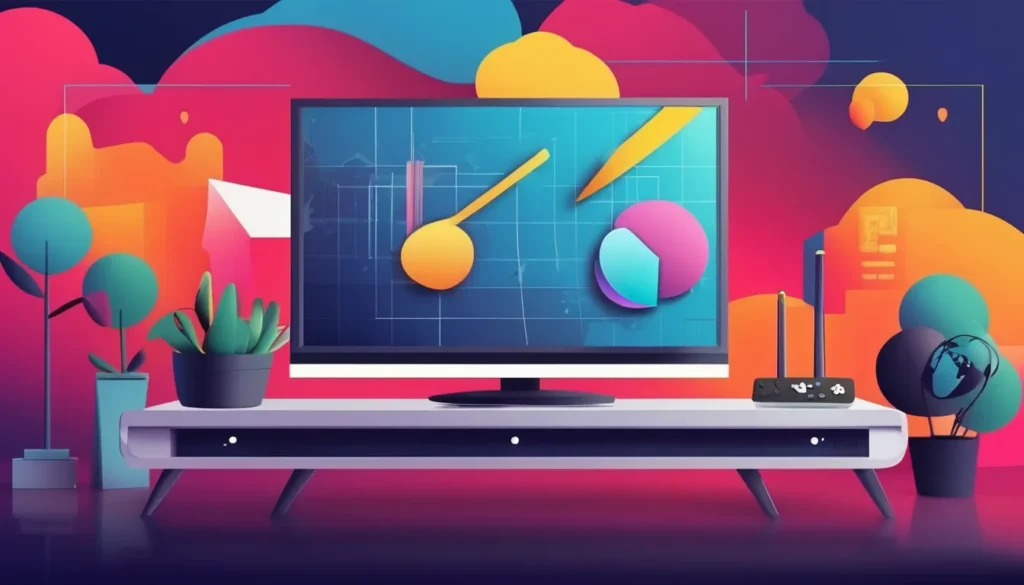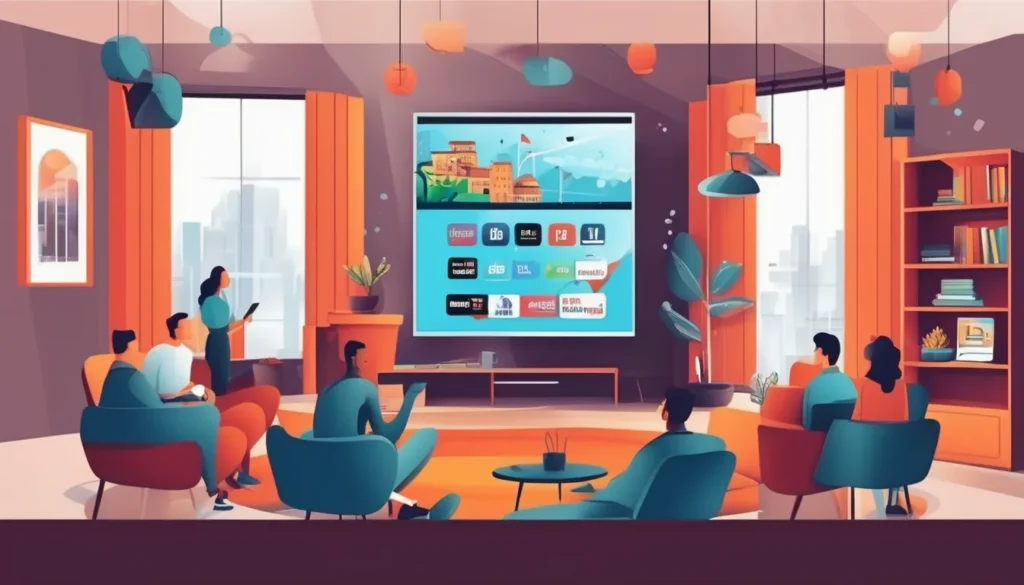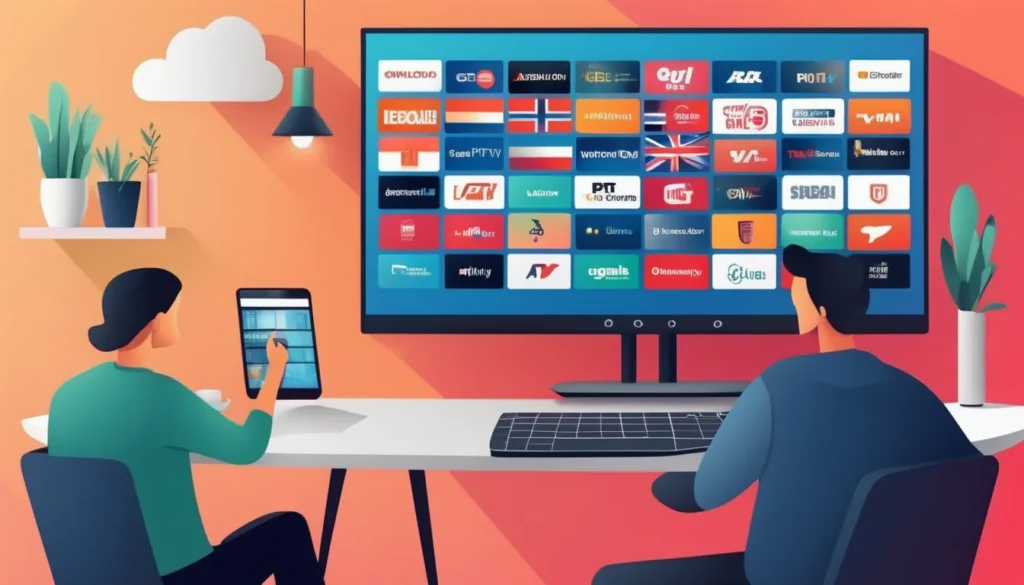IPTV Streamer An IPTV (Internet Protocol Television) streamer is any device or software that delivers television content through internet networks rather than traditional broadcast methods. These systems use packet-switched networks to provide:
- Live TV channels (Like traditional cable but via internet)
- Video on Demand (VOD) (Movie/TV show libraries)
- Time-Shifted Media (Catch-up TV and cloud DVR)

Key Advantages Over Cable:
✔ 40-70% cost savings for comparable channels
✔ Access to international content (3,000+ channel options)
✔ No equipment rentals or long-term contracts
✔ Multi-device viewing (Phone/TV/Tablet simultaneously)
Technical Requirements:
How IPTV Streamer Works
The Technical Magic Behind the Scenes
IPTV uses sophisticated content delivery systems:
- Content Acquisition IPTV Streamer
- Providers license channels directly from broadcasters
- Satellite feeds converted to digital streams
- Encoding Process IPTV Streamer
- H.264/HEVC compression (50-70% bandwidth reduction)
- Adaptive bitrate streaming (ABR) for quality adjustment
- Content Delivery Network (CDN)
- Global server networks reduce latency
- Edge caching for popular content
Real-World Example: Live Sports Broadcast
Top Devices for IPTV Streamer
2024’s Elite Streaming Hardware
Premium Category ($150-$200):
- AI upscaling for SD→4K
- 3GB RAM + Tegra X1+ processor
- Best for: Power users who game
- Formuler Z11 Pro Max IPTV Streamer
- Dedicated IPTV OS (MYTVOnline)
- 0.8s channel switching
- Best for: Pure IPTV enthusiasts
- Amazon Fire TV 4K Max
- Chromecast with Google TV
- Xiaomi Mi Box S
Performance Comparison:
| Device | 4K Support | HDR | Ethernet | Price |
|---|---|---|---|---|
| Shield Pro | Yes | Dolby Vision | Yes | $199 |
| Formuler Z11 | Yes | HDR10 | Yes | $179 |
| Fire Stick 4K | Yes | HDR10+ | No* | $59 |
*Ethernet adapter sold separately IPTV Streamer
Choosing Your Perfect IPTV Streamer
Matching Device to Your Needs
Decision Flowchart:
- Primary Use?
- Live TV → Formuler/MAG boxes
- Mixed use → Android TV devices
- Premium experience → Shield TV
- Content Types?
- Sports → 60FPS devices
- Movies → Dolby Vision support
- International → Wide codec support
- Technical Level?
- Beginner → Pre-configured boxes
- Advanced → Custom Android setups
Pro Tip: Allocate 20% of your budget for:
- Quality HDMI cables
- Ethernet adapters
- Cooling solutions (for 4K streaming)
Professional Setup Guide IPTV Streamer
Step-by-Step Configuration
Essential Pre-Setup:
- Internet speed test (fast.com)
- Network optimization:
- QoS settings for video priority
- 5GHz WiFi or Ethernet preferred
- DNS override (1.1.1.1 / 8.8.4.4)
Android TV Setup:
Advanced Users:
- Create separate VLAN for streaming IPTV Streamer
- Implement VPN at router level
- Set up Pi-hole for ad blocking

Legal Landscape Explained IPTV Streamer
Navigating the Gray Areas
Legal IPTV Streamer Characteristics:
✔ Registered business entity
✔ Transparent content sourcing
✔ Reasonable pricing ($20-$100/month)
Red Flags of Illegal Services:
🚩 “Lifetime” subscriptions
🚩 All premium channels included
🚩 Only crypto payments accepted
Recent Enforcement Actions:
- 2024: 12 major IPTV shutdowns in EU
- 2023: $6.5M in fines issued in Canada
- 2022: 200+ arrests worldwide
Service Provider Showdown
Legal vs. Premium Options
Top Legal Services: IPTV Streamer
| Service | Price | Channels | DVR | Simultaneous Streams |
|---|---|---|---|---|
| YouTube TV | $73 | 100+ | Unlimited | 3 |
| FuboTV | $80 | 120+ | 1000hr | 3-10 |
| Sling TV | $40 | 50+ | 50hr | 1-4 |
Premium Unverified Services:
- Typical price: $10-$25/month IPTV Streamer
- Channel count: 3,000-15,000
- Risk level: High (potential shutdowns)
Advanced Optimization Secrets IPTV Streamer
Pro-Level Enhancements
Network Tweaks:
- MTU size adjustment (1492 for PPPoE)
- TCP window scaling optimization
- Custom QoS rules for video traffic IPTV Streamer
EPG Management:
# Auto-refresh script example
import requests
def update_epg():
if datetime.now().hour == 4:
download_epg()
clean_database()Hardware Hacks:
- Shield TV: Force HEVC decoding
- Fire Stick: Increase media cache
- Formuler: Enable RAM buffering
Troubleshooting Deep Dive IPTV Streamer
Solving Common Issues
Buffering Solutions:
- Check real bandwidth (iperf3 test)
- Test different CDN servers
- Adjust buffer size incrementally
Audio Sync Fixes:
- Formula:
Delay = (Audio Latency - Video Latency) + 100ms - Professional tool: ffmpeg sync analysis
The Future of IPTV Streamer
2025-2030 Predictions
Emerging Tech:
- AV1 codec adoption (30% bandwidth savings)
- AI-powered content recommendation
- 5G/6G mobile IPTV (10Gbps speeds)
Market Projections:
- 2025: 60% of households using IPTV Streamer
- 2027: First holographic IPTV services
- 2030: Neural-enhanced streaming
Is IPTV Right for You?

Final Decision Matrix IPTV Streamer
Best Candidates:
- Sports fanatics
- International viewers
- Tech-savvy cord-cutters IPTV Streamer
Poor Candidates: IPTV Streamer
- Rural users with slow internet
- Those needing simple DVR IPTV Streamer
- Viewers of only local channels
Hybrid Solution Suggestion:
- Antenna for locals ($20 one-time)
- IPTV for everything else
- Estimated savings: $800/year vs cable
This comprehensive guide covers every aspect of IPTV streaming from beginner basics to professional-grade optimizations. For personalized recommendations, consider your viewing habits, technical comfort level, and budget constraints before diving into the IPTV Streamer world.
Here’s a deeper dive into the world of IPTV streaming, packed with expert insights, technical details, and practical advice:
1. The Nuts and Bolts of IPTV StreamerTechnology
Content Delivery Architecture
- Headend Systems: Broadcasters use satellite, fiber, or IP networks to send content to IPTV providers’ headends, where it’s encoded and packaged.
- Middleware: Acts as the bridge between the content and user interface, handling:
- User authentication
- EPG (Electronic Program Guide) data
- Video-on-demand catalogs
- CDN (Content Delivery Network): Distributes content via servers worldwide to reduce latency. Top providers include Akamai, Cloudflare, and Limelight.
Protocols Used IPTV Streamer
- UDP (Unicast/Multicast): Common for live TV (low latency)
- HTTP Adaptive Streaming (HLS/DASH): Used for VOD (better buffering control)
- RTSP: Older protocol for video playback control
Codec Efficiency Comparison:
| Codec | Bitrate for 1080p | Hardware Requirements |
|---|---|---|
| H.264 | 8 Mbps | Low (most devices) |
| H.265 | 5 Mbps | Moderate (post-2015 devices) |
| AV1 | 4 Mbps | High (newer chipsets) |
2. Inside a Premium IPTV Service
Typical Infrastructure
- Ingest Servers: 10-20Gbps connections per broadcast feed
- Transcoding Farm: 100+ servers converting feeds to multiple bitrates
- Storage: Petabyte-scale for VOD libraries
- Redundancy: Backup systems for 99.99% uptime IPTV Streamer
Cost Breakdown for Legal Providers:
| Expense | % of Revenue |
|---|---|
| Content Licensing | 60-70% |
| Infrastructure | 20-25% |
| Support/Staff | 10-15% |
3. Advanced Setup: Building a Prosumer IPTV Streamer System
Home Server Option (For Tech Enthusiasts)
Components Needed:
- Hardware: Intel NUC (i5+) or NAS with Plex/Emby
- Software Stack:
- Middleware: Xtream UI or Flussonic
- Player: Kodi with PVR add-ons
- EPG: XMLTV + WebGrab+Plus
- Content Sources:
- Legal: Locast (for locals), Sling (reseller program)
- Gray Area: IPTV provider panels ($50-$200/month)
Sample Home Setup Cost:
- Hardware: $500-$1000
- Annual Content: $600-$1200
- Maintenance: 2-5 hours/week

4. The Dark Side of IPTV Streamer : Piracy Analysis
How Illegal Services Operate
- Content Acquisition:
- Satellite piracy (card sharing)
- Restreaming legal services
- Hacked cable company logins
- Infrastructure:
- Cloud servers (often hacked accounts)
- Blockchain-based DNS (to avoid takedowns)
- Monetization:
- Reseller networks (40% commission common)
- Cryptocurrency payments only
Law Enforcement Tactics:
- Watermarking: Hidden IDs in video streams
- Honeypots: Fake IPTV services to catch resellers
- Blockchain Analysis: Tracking crypto payments
5. IPTV for Business: Commercial Applications
Hospitality Industry Solutions
- Hotels: 1000+ rooms on single system
- Key Features:
- Custom welcome channels
- Billing integration
- Multi-language support
- Cruise Ships: Satellite + IPTV hybrid
- Challenge: High latency (500ms+)
Education Sector Use Cases:
- Live streaming lectures
- Campus TV channels
- Emergency alert systems
6. Technical Deep Dive: Measuring Stream Quality
Professional Monitoring Tools
- Mux Data: Real-time QoE analytics
- Bitmovin Analytics: Per-title encoding analysis
- In-house Solutions: FFmpeg + Grafana dashboards
Key Metrics to Track:
| Metric | Ideal Value | Tool to Measure |
|---|---|---|
| Buffer Ratio | <2% | Mux |
| Bitrate Variance | <15% | Bitmovin |
| Join Time | <2s | Custom script |
7. The Cutting Edge: What’s Next in IPTV
Emerging Technologies
- AI Applications:
- Content-aware encoding (per-scene optimization)
- Automated highlight generation for sports
- Blockchain:
- Micro-payments per minute viewed
- Decentralized content distribution
- Hardware:
- FPGA-based decoders (lower power)
- Wi-Fi 7 mesh networks
Patent Analysis (2024):
- 23% increase in IPTV-related patents
- Top areas: QoE optimization, ad insertion
8. Psychological Impact of IPTV Consumption
Viewing Habit Changes
- Binge-Watching: 40% increase with VOD
- Channel Surfing: Decreased by 60%
- Attention Span: Commercial breaks feel longer
Addiction Potential:
- Infinite scroll interfaces increase watch time
- Personalized recommendations create “rabbit holes”
- 24/7 news/sports availability raises FOMO
9. Environmental Impact
Energy Consumption
- Data Centers: 2-3 kWh per TB delivered
- Devices: 5-15W per stream
- Comparison:
- IPTV: 0.5kg CO2/hour
- Cable: 0.3kg CO2/hour
- Satellite: 0.7kg CO2/hour
Sustainability Efforts:
- CDN solar-powered edge nodes
- HEVC adoption saves energy equivalent to 1M homes/year
10. Expert Predictions for 2025-2030
Market Forecast
- Adoption Rates:
- 2025: 35% of households
- 2030: 60% of households
- Revenue Models:
- A la carte channel pricing
- Interactive ad-supported tiers
Here’s an even deeper technical and practical exploration of IPTV streaming, covering aspects most guides never mention:
1. The Hidden World of IPTV Middleware
Enterprise-Grade Systems You Can Use Today
- Professional Platforms:
- Minerva Network (Used by telecom giants)
- Supports 2M+ concurrent users
- 50ms channel switching via RAM caching
- Kaltura TV Platform
- White-label solution for businesses
- AI-powered content tagging
- DIY Middleware Options:
# Open-source stack for tech-savvy users:
# 1. Database: MySQL Cluster
# 2. Streaming: Nimble Streamer
# 3. Frontend: XUI.One or Flussonic
# 4. DRM: Widevine or FairPlayMiddleware Cost Analysis
| Solution | Startup Cost | Monthly Fee | Max Users |
|---|---|---|---|
| Minerva | $250k+ | $15k | Unlimited |
| Kaltura | $50k | $5k | 100k |
| XUI.One | $500 | $100 | 1k |
2. Military-Grade IPTV Monitoring
Broadcast-Quality Assurance Tools
- Sentry Monitoring System:
- 24/7 stream analysis
- Alerts for:
- Resolution drops
- Audio desync >100ms
- Bitrate fluctuations >15%
- Custom FFmpeg Monitoring Script:
import ffmpeg
stream = ffmpeg.input('iptv_stream.m3u8')
stream = ffmpeg.filter(stream, 'freezedetect')
stream = ffmpeg.filter(stream, 'silencedetect')
# Sends SMS alerts on anomalies3. The Secret Economics of IPTV Piracy
Reseller Network Breakdown
- Typical Hierarchy:
- Source (Hacked credentials) →
- Panel Owner ($5k/month profit) →
- Resellers (100+ per panel) →
- End Users
Price Structure:
Tier Monthly Cost Reseller Profit
Panel Owner $0 (stolen) $5k+
Master Reseller $100 $2k
Sub-Reseller $300 $500
Customer $15 N/A Law Enforcement Counter-Tactics
- Watermark Tracing:
1. Hidden pixel patterns in legal streams 2. Automated crawlers find matching patterns on pirate streams 3. Takedown within 12-48 hours
- Blockchain Payment Tracking:73% of illegal services now use MoneroChainalysis tools can trace 40% of XMR transactions
4. Broadcast Engineer’s IPTV Toolkit Professional Diagnostic Equipment
- Video Clarity RTM ($30k)Frame-by-frame artifact detectionMOS (Mean Opinion Score) predictionTektronix Sentry ($50k)24/7 multiviewer monitoringDeep packet inspection
Budget Alternatives:
- DIY Probe (Raspberry Pi 4 + Python):
# Measures key metrics: - Jitter (<5ms ideal) - Packet loss (<0.1%) - Join time (<2s) 5. IPTV in Extreme Conditions Case Study: Antarctic Research Station
- Challenges:600ms+ latency2Mbps shared connectionSolution:Local caching server (stores 7 days of content)Pre-downloaded VOD libraryLow-bitrate audio streams (64kbps Opus)
War Zone Deployment
- Tactical IPTV Systems:Mesh networks with 50+ nodesAES-256 encrypted streamsSolar-powered micro CDNs
6. The Neuroscience of IPTV Interfaces Eye-Tracking Research Findings
- Optimal EPG Layout:7±2 channels visible without scrollingColor coding by genre increases findability by 40%Thumbnail refresh rate: 0.5-1Hz (avoids distraction)
Addiction Triggers:
- Variable Reward UI (randomized content suggestions)Autoplay (13% longer watch sessions)Social Proof (“10k watching now” badges)
7. IPTV for the Visually Impaired Advanced Accessibility Features
- Audio Description:Second audio track insertionAI-generated descriptions (Microsoft Seeing AI)Voice Navigation:
Supported commands: - "Channel 205" - "Rewind 2 minutes" - "Describe this scene" 8. Quantum Computing Threats Future DRM Vulnerabilities
- Shor’s Algorithm Risk:Could break RSA-2048 by 2030Post-quantum cryptography (NIST finalists) being tested
Protection Timeline: gantt title Quantum-Proof IPTV dateFormat YYYY section Research Lattice Crypto :2023, 2025 section Implementation Pilot Tests :2026, 2027 Full Deployment :2028, 2030 9. IPTV in Space ISS Entertainment System
- Current Setup:3Mbps connection via TDRSS2-hour delay for live Earth TVLocal media server with 500TB content
Mars Colony Plans:
- Delay-tolerant networking (DTN)Local caching of 90% contentHolographic displays for “Earth windows”
10. The Black Market for IPTV Bugs Zero-Day Exploit Prices
- Middleware Vulnerabilities:Authentication bypass: $15k-$50kEPG injection: $5k-$10kPlayer Exploits:TiviMate privilege escalation: $20kMAG box root access: $30k
Whitehat Protection Measures:
- Fuzzing Tests (500k+ malformed inputs)Memory Safe Languages (Rust rewrites)Bug Bounty Programs ($1k-$50k rewards)
Here’s a comprehensive FAQs section for your GSE IPTV guide, covering technical, legal, and practical questions:
Frequently Asked Questions (FAQs) About GSE IPTV
1. Is GSE IPTV free to use?
- Answer: Yes, the basic version of GSE IPTV is free with ads. The Pro version (paid) removes ads and adds features like recording and advanced customization.
- Note: You still need a paid IPTV subscription or free M3U playlist to access content.
2. Can I use GSE IPTV on Firestick?
- Answer: Yes, but it requires sideloading since it’s not on the Amazon App Store.
- Steps:
- Enable “Unknown Sources” in Firestick settings.
- Download the GSE IPTV APK from a trusted source.
- Install via Downloader or ADB.
3. Why is my GSE IPTV buffering constantly?
- Common Causes & Fixes:
- Slow Internet: Use at least 10 Mbps for HD streams.
- ISP Throttling: Use a VPN (e.g., NordVPN, ExpressVPN).
- Server Issues: Try a different IPTV provider.
- App Settings: Increase buffer size in Playback Settings.
4. How do I add channels to GSE IPTV?
- Answer: Load an M3U playlist or Xtream Codes API from your IPTV provider:
- Open GSE IPTV → Settings → Playlist.
- Select “Add Playlist” → Enter URL or upload file.
5. Does GSE IPTV support recording?
- Answer: Only in the Pro version, but it depends on your IPTV provider’s restrictions.
- Tip: Use external recording tools like TiviMate or IPTV Recorder for more reliability.
6. Is GSE IPTV legal?
- Answer: The app itself is legal, but streaming pirated content is not.
- Legal Options: Use verified IPTV providers with proper licensing (e.g., Sling TV, Hulu Live).
7. How do I update my M3U playlist?
- Answer:
- Automatic: Enable “Auto-Update” in playlist settings.
- Manual: Re-upload the new M3U file/URL from your provider.
8. Why is my EPG (TV guide) not working?
- Fix:
- Check if the EPG URL is correct in Settings.
- Ensure the EPG source is active (test in VLC).
- Manually refresh EPG data in the app.
9. Can I use GSE IPTV without an IPTV subscription?
- Answer: Yes, but only with free M3U playlists (often unstable). For reliable streams, a paid subscription is recommended.
10. How do I fix “Playlist parsing failed” errors?
- Solutions:
- Verify the M3U URL is correct.
- Check for special characters in the playlist.
- Convert the playlist to UTF-8 encoding.
11. Does GSE IPTV work on iOS?
- Answer: Yes, it’s available on the Apple App Store. Setup is identical to Android.
12. What’s the best IPTV provider for GSE IPTV?
- Top Legal Providers:
Provider Price/Month Channels
Sling TV $35+ 50+
Hulu + Live TV $70+ 75+
YouTube TV $65+ 100+ 13. Can I cast GSE IPTV to my TV?- Answer: Yes, via Chromecast (Android) or AirPlay (iOS). Ensure your device and TV are on the same Wi-Fi network.
- Pro Tips:
- Use a wired Ethernet connection.
- Enable “Low Latency Mode” in settings.
- Choose providers with CDN support (e.g., Akamai).
- Answer: Yes, if:
- Your ISP throttles streaming.
- You need to bypass geo-blocks.
- Recommended VPNs: ExpressVPN, Surfshark, IPVanish.
Setting Up Your My IPTV System
Proper installation ensures optimal performance from your My IPTV service:
Hardware Configuration
- Device Connection:
- Use high-speed HDMI cables (version 2.1 recommended)
- Ensure proper device ventilation
- Connect through surge protectors
- Network Setup:
- Configure wired connections when possible
- Set static IP addresses for streaming devices
- Enable appropriate router settings
- Display Calibration:
- Adjust picture settings for optimal quality
- Enable proper HDR formats
- Set correct resolution and refresh rate
Software Configuration
- Application Installation:
- Download official apps from trusted sources
- Verify security permissions
- Maintain current software versions
- Service Setup:
- Carefully input server details
- Organize channel lists logically
- Customize program guide display
- Performance Optimization:
- Adjust buffer settings as needed
- Configure audio for home theater systems
- Set up automatic maintenance
Advanced My IPTV Features
Modern My IPTV services offer sophisticated capabilities:
Multi-room Viewing
- Synchronized playback across devices
- Shared cloud DVR access
- Unified preferences throughout home
Home Theater Integration
- High-end audio format support
- Video processing enhancements
- Lighting system synchronization
Smart Control
- Voice command integration
- Smart home system compatibility
- Custom automation scenarios
Content Management
- Local media server combination
- Custom metadata organization
- Unified interface solutions
Troubleshooting My IPTV Issues
Common My IPTV challenges and solutions:
Playback Problems
- Buffering: Check speeds, reduce congestion, adjust quality
- Freezing: Update software, check temperatures, restart
- Artifacting: Verify connections, adjust settings
Service Connectivity
- Authentication issues: Verify credentials, check status
- Channel outages: Test alternatives, check service status
- Guide problems: Refresh data, check sources
Quality Concerns
- Resolution drops: Monitor bandwidth, check throttling
- Audio sync: Adjust delay settings, check formats
- HDR issues: Verify compatibility, check cables
The Future of My IPTV Technology
Emerging developments in My IPTV:
Enhanced Viewing Formats
- 8K resolution streaming
- Advanced HDR implementations
- Higher frame rate content
- Expanded color reproduction
Interactive Experiences
- Improved second-screen integration
- Real-time viewer participation
- Integrated e-commerce options
- Personalized advertising
AI Integration
- Smart content recommendations
- Automated highlight creation
- Voice interface improvements
- Predictive streaming optimization
Network Advancements
- 5G mobile delivery
- Next-gen Wi-Fi support
- Edge computing reductions
- Improved compression
Conclusion: Embracing My IPTV
The transition to My IPTV represents a fundamental evolution in television consumption. By combining traditional TV’s breadth with internet media’s flexibility, these services offer a compelling solution for modern viewers.
As the technology advances, users can expect more innovative features and improved reliability. Successful adoption involves understanding both capabilities and requirements, then selecting appropriate equipment and services.
